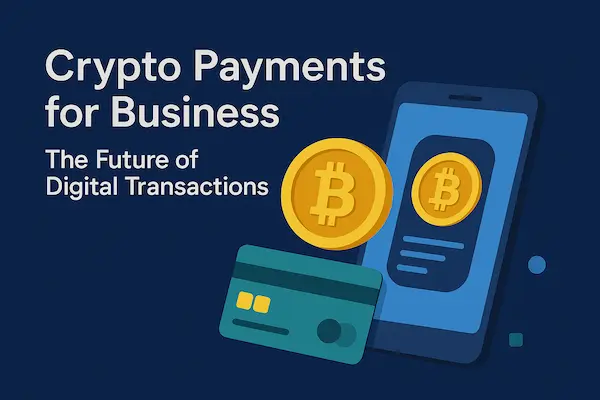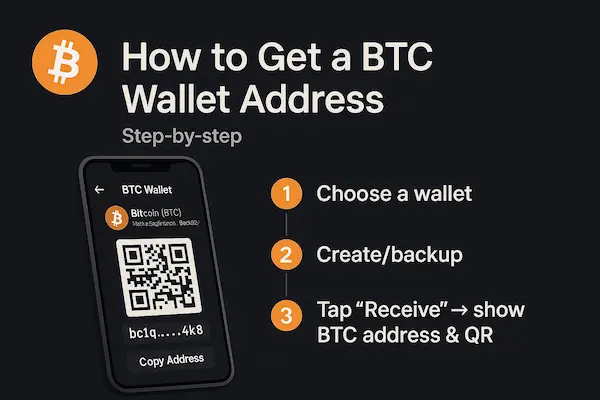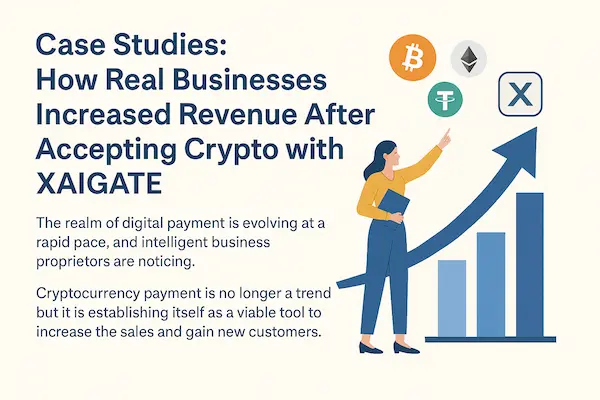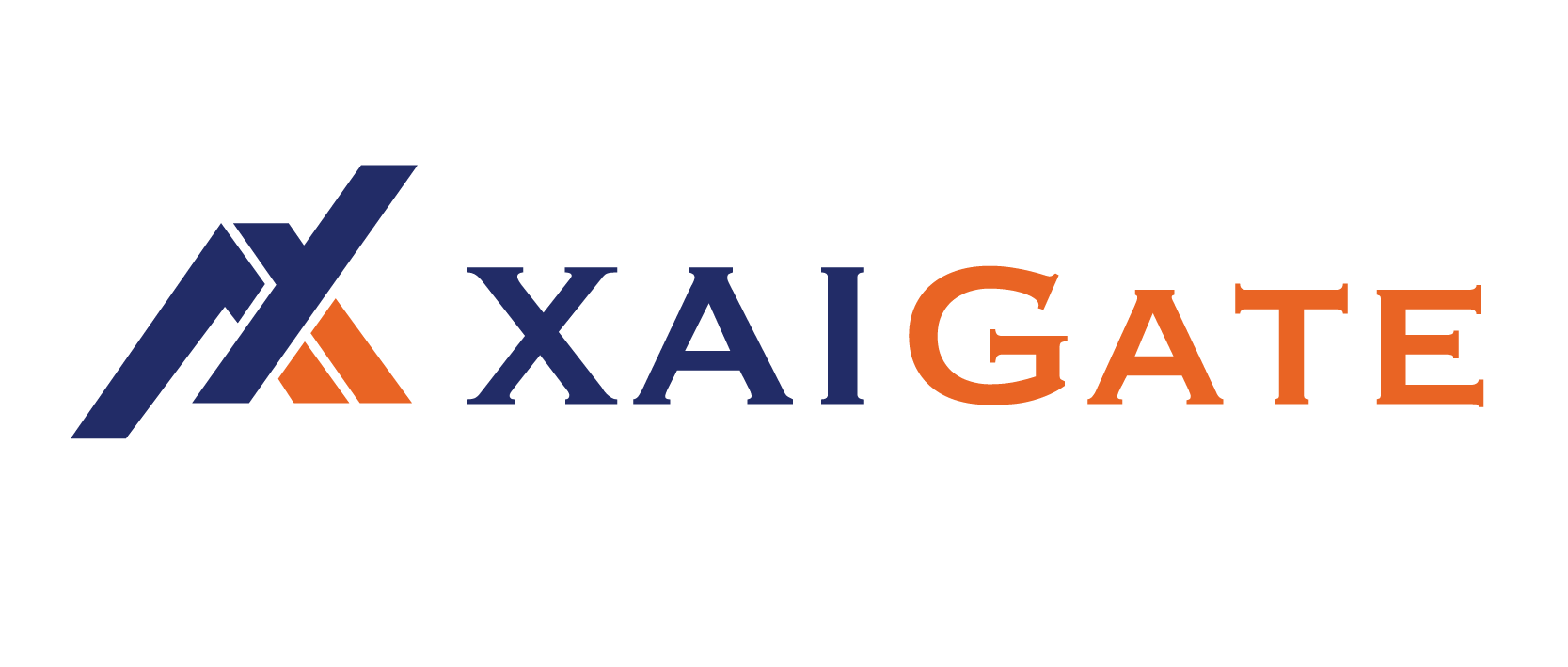Contents
- 1 1. Introduction: Why Crypto Payments for Business Are Transforming Global Commerce
- 2 2. History and Evolution of Crypto Payments
- 3 3. Benefits of Crypto Payments for Business
- 4 4. Integration Models for Crypto Payments
- 5 5. Industry-Specific Applications of Crypto Payments
- 6 6. Case Studies
- 7 7. Security Best Practices
- 8 8. Future Trends in Crypto Payments for Business (2026–2030)
- 9 9. Step-by-Step Guide: How Businesses Can Accept Crypto Payments
- 10 Conclusion: Why Businesses Must Act Now
- 11 FAQs on Crypto Payments for Business
1. Introduction: Why Crypto Payments for Business Are Transforming Global Commerce
Crypto Payments for Business are no longer a futuristic concept. What once seemed like a niche option for tech-savvy startups is now becoming a practical payment method for companies of all sizes. From small online shops to multinational corporations, more businesses are exploring digital currencies as a way to reduce costs, reach global customers, and stay ahead of competitors.
The shift is happening quickly. By 2026, leading payment processors, e-commerce platforms, and even traditional banks are introducing tools that make it easier for merchants to accept cryptocurrency. Whether it’s Bitcoin, Ethereum, or stablecoins like USDT and USDC, crypto payments give businesses faster transactions, stronger security, and lower processing fees compared to credit cards and bank transfers.
For many companies, the question is no longer “Should we try crypto?” but rather “How do we integrate crypto payments into our business safely and effectively?” This article takes a deep dive into the benefits, challenges, and real-world applications of crypto payments, showing why they are becoming one of the most important innovations in modern commerce.
2. History and Evolution of Crypto Payments
The story of crypto payments for business has been one of rapid change. What began as a small experiment has now become a global trend reshaping commerce.
From Pizza to Global Commerce
In 2010, Bitcoin was famously used to buy two pizzas for 10,000 BTC. While lighthearted at the time, this event proved digital assets could function as real money. It also sparked the idea that businesses might one day accept cryptocurrency as payment, bypassing banks and reducing fees.
Early Business Adoption
By 2014, companies like Overstock, Microsoft, and Shopify started accepting Bitcoin. Adoption was limited, but these pioneers gained visibility and showed that crypto could be used in real commerce. For smaller businesses, the ability to process cross-border payments without credit card fees was especially attractive.
The Rise of Payment Gateways
Between 2017 and 2020, services like BitPay, Coinbase Commerce, and BTCPay Server made integration easier. APIs and plugins allowed merchants to accept crypto while receiving fiat if they preferred. This step removed complexity and opened the door for mainstream businesses.
From Experiment to Mainstream
By 2026, stablecoins such as USDT, USDC, and PYUSD reduced volatility risks, while new regulations increased trust. SMEs in emerging markets now rely on crypto for stable transactions, and global corporations experiment with blockchain settlements. Crypto payments for business have shifted from novelty to necessity.

3. Benefits of Crypto Payments for Business
For modern companies, adopting cryptocurrency isn’t only about keeping up with trends. It’s about solving real problems: high fees, slow cross-border transactions, fraud risks, and limited customer reach. Here are the key advantages businesses can gain.
1. Lower Transaction Fees
Traditional payment processors charge between 2% and 5% per transaction, which can eat into margins—especially for SMEs and e-commerce stores. By contrast, crypto gateways usually charge 0.1% to 1%, helping companies save thousands annually.
Table 1: Average Fees and Settlement Speed – Crypto vs. Traditional Payments
| Payment Method | Average Fees | Settlement Speed |
|---|---|---|
| Credit Cards | 2–3% | 2–5 Days |
| Bank Transfers | 1–2% | 1–3 Days |
| Crypto Payments | 0.1–1% | Seconds–Minutes |
With lower costs and near-instant settlement, crypto payments for business improve cash flow and profitability.
2. Instant Cross-Border Transactions
Cross-border trade is often slowed down by intermediaries and conversion fees. Crypto eliminates these obstacles, allowing businesses in Asia, Europe, or the US to transact directly within minutes. This is especially valuable for global e-commerce and service providers working with international clients.
3. Transparency and Security
Every crypto transaction is recorded on a public blockchain. Unlike credit card systems where fraud and chargebacks are common, crypto provides transparency and near-immunity to tampering. For industries exposed to higher risks—such as online gaming, travel, or digital services—this makes crypto an attractive option for reducing disputes and fraud losses.
4. Expanding Customer Reach
Crypto payments open doors to new demographics and markets. Millennials and Gen Z, who are digital-first consumers, increasingly prefer paying with digital assets. At the same time, businesses gain access to regions where credit cards are less common but crypto adoption is high, expanding customer bases without traditional banking barriers.
5. Stablecoins as a Hedge Against Volatility
Volatility remains a concern with Bitcoin and Ethereum, but stablecoins like USDT, USDC, and PYUSD provide stability by being pegged to fiat currencies.
Table 2: Stablecoins vs. Volatile Cryptocurrencies in Business Payments
| Feature | Stablecoins (USDT, USDC) | BTC/ETH |
|---|---|---|
| Volatility Risk | Very low | High |
| Adoption Rate | Growing fast | Established |
| Best Use Cases | Daily payments, SMEs, NGOs | High-value, investment |
For most businesses, stablecoins offer the best balance between innovation and security, making them ideal for everyday commerce.

4. Integration Models for Crypto Payments
Businesses have several options when integrating crypto payments. The right model depends on company size, technical resources, and compliance needs. Generally, there are three main approaches: centralized gateways, decentralized solutions, and hybrid models.
Centralized Gateways
Centralized providers such as Coinbase Commerce or Binance Pay offer the easiest way to start. They provide ready-made plugins, customer support, and automatic fiat conversion. For SMEs or e-commerce platforms, this model is attractive because it requires little technical knowledge. The downside is reliance on a third party and mandatory KYC/AML procedures, which may limit flexibility.
Decentralized / Open-Source Solutions
Decentralized options like BTCPay Server or XaiGate give businesses full control over their transactions. They are open-source and can be hosted independently, meaning no third party holds customer data. Fees are near zero, and businesses avoid strict compliance requirements. However, setup requires technical skills, and support is limited compared to centralized services.
Hybrid Models with Fiat Settlement
Hybrid solutions combine the best of both worlds. Businesses accept crypto but instantly convert it into fiat currency to avoid volatility. Platforms like BitPay or XaiGate allow this option. It provides the benefits of global crypto acceptance without the risks of price fluctuations, making it especially attractive for enterprises that need predictable cash flow.
Table 3: Centralized vs. Decentralized vs. Hybrid Crypto Payment Models
| Feature | Centralized (Coinbase, Binance) | Decentralized (BTCPay, XaiGate) | Hybrid (BitPay, XaiGate) |
|---|---|---|---|
| KYC/AML | Required | Not required | Required (varies) |
| Fees | 0.5–1% | Near 0% | 0.5–1% |
| Data Control | Third party holds data | Full business control | Partial control |
| Ease of Setup | Very easy | Technical knowledge needed | Easy–Medium |
| Volatility Exposure | Yes | Yes | Minimal (auto-conversion) |
For most businesses, centralized or hybrid solutions provide the easiest entry point, while decentralized gateways appeal to companies that prioritize privacy, control, and lower costs.
5. Industry-Specific Applications of Crypto Payments
The impact of crypto payments for business is most visible when looking at specific industries. Different sectors have adopted digital assets for different reasons—from reducing costs to reaching new customers.
1. E-commerce and Retail
Online shops and digital marketplaces benefit from lower fees and global reach. Shopify and WooCommerce now provide plugins that let merchants accept Bitcoin, Ethereum, and stablecoins. This helps small businesses compete with larger retailers by cutting payment costs and offering faster checkout. For customers in regions with limited banking access, crypto becomes the easiest way to shop online.
2. Travel and Hospitality
From airlines like CheapAir to hotel booking platforms such as Travala, the travel industry is embracing crypto. Tourists often face high conversion fees and unreliable banking abroad; crypto offers a seamless alternative. Some luxury hotels already accept USDT and BTC, allowing international guests to book instantly without worrying about currency exchange.
3. Gaming and iGaming
The gaming sector, including online casinos, was among the first to adopt crypto payments. Players prefer crypto for its privacy, speed, and lower costs. With blockchain-based games also on the rise, paying in tokens or stablecoins feels natural for this audience. For operators, crypto reduces fraud and chargeback issues.
4. NGOs and Charities
Nonprofits are using crypto to receive donations globally. Organizations like UNICEF have accepted crypto to improve transparency, since every donation is visible on-chain. For donors, this ensures accountability. Stablecoins, in particular, make it easier for charities to avoid volatility and receive reliable funding across borders.
5. Freelancers and Remote Workforce
Freelancers and contractors around the world use crypto to get paid quickly, avoiding PayPal fees or long bank delays. Stablecoins like USDC are especially popular, allowing workers in countries with unstable currencies to receive value that holds steady. For businesses hiring globally, this provides a faster, cheaper payroll solution.

6. Case Studies
Real-world examples show how different types of organizations are adopting crypto payments. These case studies illustrate the opportunities and challenges businesses face when moving toward digital assets.
1. Tesla and Bitcoin Payments
In 2021, Tesla briefly accepted Bitcoin for car purchases, making headlines worldwide. While the program was paused due to environmental concerns, it proved that major corporations were willing to experiment with crypto. For businesses, Tesla’s move highlighted both the marketing power of crypto adoption and the risks of volatility. The case also showed how public perception can impact a company’s crypto strategy.
2. PayPal and Visa Integrations
Financial giants like PayPal and Visa have integrated crypto into their services, offering users the ability to pay with Bitcoin, Ethereum, and stablecoins. PayPal’s crypto checkout feature allows millions of merchants to indirectly accept digital currencies without changing their systems. Visa, meanwhile, has piloted stablecoin settlement on its network. These moves signal that crypto payments are no longer fringe—they’re entering mainstream finance.
3. SMEs in Emerging Markets
Small and medium enterprises (SMEs) in countries with unstable currencies are turning to stablecoins for survival. In parts of Africa and Latin America, merchants accept USDT and USDC to avoid inflation and access global customers. Unlike Tesla or PayPal, these businesses use crypto out of necessity, not branding. Their experience shows the practical value of crypto payments for business in regions underserved by traditional banking.
7. Security Best Practices
Security is one of the most important considerations when adopting crypto payments for business. While blockchain itself is highly secure, weak practices at the business level can lead to financial losses. Unlike traditional systems, crypto transactions cannot be reversed, which means that once funds are stolen, they are usually gone forever. To protect both customers and revenue, companies must adopt strong security measures across technology, processes, and staff training.
Multi-Signature Wallets for Control and Oversight
A common vulnerability in business crypto operations is giving one individual full access to company funds. Multi-signature wallets solve this by requiring approvals from two or more parties before a transaction can be executed. For example, a company could set up a system where the finance manager and the CEO both need to sign before funds are transferred. This reduces the risk of theft, prevents internal fraud, and adds a layer of oversight. Many larger companies and nonprofits already use multi-sig wallets for treasury management because they provide a governance model that mirrors traditional corporate controls.
Cold Storage for Long-Term Protection
Hot wallets (online wallets) are essential for day-to-day transactions, but they are constantly exposed to the internet, making them prime targets for hackers. By contrast, cold storage solutions such as hardware wallets or paper wallets keep private keys offline, away from potential attacks. Best practice for businesses is to keep only the operational amount in hot wallets, while storing the majority of funds in cold storage. This is similar to how banks maintain liquidity for daily withdrawals but secure the rest in vaults. Companies like Coinbase and Binance also use this strategy for their own reserves, proving its effectiveness.
Smart Contracts to Reduce Disputes
Smart contracts can bring additional security and trust to business transactions. For instance, a freelancer marketplace can use a smart contract that automatically releases funds only when work is confirmed as complete. This prevents fraud and builds trust between parties who may not know each other personally. Escrow services powered by blockchain remove the need for intermediaries while ensuring that agreements are honored. For businesses expanding internationally, smart contracts reduce disputes and improve customer confidence.
Employee Training and Risk Awareness
Technology alone cannot prevent all risks. Human error remains one of the biggest security threats. Employees may fall victim to phishing attacks, social engineering, or mishandle private keys. A single mistake can compromise an entire company wallet. That is why training is critical. Businesses should implement regular security workshops to teach staff how to identify phishing emails, handle wallets securely, and follow internal approval processes. Just as companies invest in compliance and data protection training, crypto security education should be part of the culture.
Working with Trusted Payment Gateways
Not every business has the resources to build a robust security system in-house. In such cases, working with a trusted crypto payment gateway is the safest option. Reputable providers like Coinbase Commerce or XaiGate offer enterprise-level security, including fraud monitoring, automatic settlements, and secure wallet management. This reduces the burden on businesses and ensures that customer payments are processed safely. However, due diligence is essential—companies should always evaluate the track record and compliance standards of the providers they work with.
By combining these best practices—multi-signature wallets, cold storage, smart contracts, employee training, and trusted partners—companies can significantly reduce risks. With the right framework, crypto payments for business can be as safe as, or even safer than, traditional payment methods.
8. Future Trends in Crypto Payments for Business (2026–2030)
The next five years will be decisive for the future of digital payments. As adoption accelerates, crypto payments for business will evolve far beyond simple Bitcoin transactions, shaped by new technologies, regulatory frameworks, and changing consumer expectations. Several major trends are already visible today and are expected to define the landscape by 2030.
1. The Rise of Stablecoins and CBDCs
Stablecoins have already become the most practical tool for businesses due to their price stability. In 2026, USDT and USDC dominate global crypto payments, while PayPal’s PYUSD is quickly gaining traction. For merchants, stablecoins solve the volatility problem while preserving the advantages of fast, borderless transactions.
At the same time, central banks are rolling out Central Bank Digital Currencies (CBDCs). China’s digital yuan and the European Union’s upcoming digital euro are examples of how governments plan to modernize money. By 2030, businesses may be handling both stablecoins and CBDCs side by side. This will blur the line between government-backed money and decentralized digital assets, offering companies more payment flexibility but also increasing regulatory obligations.
2. Mainstream Adoption of Tap-to-Pay and QR Payments
The user experience of crypto payments is rapidly improving. In countries like China and India, QR code payments are already standard. Crypto wallets are now adopting the same model, allowing instant transactions by scanning a code. Meanwhile, “Tap-to-Pay” features using NFC (near-field communication) are being integrated into crypto debit cards and mobile wallets.
For physical retail, this means customers could pay for groceries, hotel stays, or public transport in USDC or BTC as easily as tapping a phone. As this technology spreads, crypto will no longer feel “different” from existing digital payments—removing one of the last barriers to mainstream use.
3. Embedded Crypto Payments in Apps and Platforms
One of the biggest shifts will be the rise of embedded finance, where payments are built directly into platforms. Just as ride-hailing apps like Uber integrate card payments, future e-commerce sites, social media platforms, and even games will integrate crypto natively. Customers won’t need to move between wallets or gateways; they will simply pay in crypto as part of their normal user journey.
For businesses, this will reduce friction and improve conversions. Platforms like Shopify and Stripe are already experimenting with crypto integrations, suggesting that by 2030, embedded crypto checkouts will be the norm rather than the exception.
4. AI and Blockchain Synergy for Fraud Detection
As crypto adoption grows, so does the need for intelligent fraud detection. Artificial intelligence (AI) is increasingly being used to monitor blockchain transactions in real-time, identifying suspicious patterns that humans might miss. For example, AI systems can flag unusual wallet activity or detect potential scams before money leaves a business account.
This synergy of AI and blockchain will provide businesses with smarter security, reducing risks without slowing down transactions. Companies that combine these tools will gain a competitive advantage by offering both safety and speed to their customers.
5. Global Regulatory Alignment
Finally, regulation will shape the future of crypto payments for business more than any other factor. The European Union’s MiCA framework, effective by 2026, is expected to inspire similar policies in Asia, Africa, and Latin America. Over time, regulations will become more harmonized, reducing the uncertainty businesses face today.
Clearer rules will also encourage institutional adoption. When major banks, insurance companies, and Fortune 500 firms have legal clarity, they will expand their crypto services. This, in turn, will push crypto payments deeper into mainstream business ecosystems.

9. Step-by-Step Guide: How Businesses Can Accept Crypto Payments
Adopting crypto payments for business may sound technical, but with today’s tools, even small merchants can integrate digital currencies quickly. Here’s a practical roadmap for companies looking to get started.

Step 1: Choose the Right Crypto Payment Gateway
The first decision is selecting a gateway that fits your needs. Centralized options like Coinbase Commerce are beginner-friendly, decentralized tools like BTCPay Server give you full control, while hybrid solutions like XaiGate combine ease of use with auto-conversion to fiat.
Step 2: Set Up a Secure Wallet
A crypto wallet is where your funds will be stored. Businesses should use a combination of hot wallets (for daily operations) and cold storage (for long-term reserves). Security practices such as multi-signature authorization should be considered from the start.
Step 3: Integrate the Gateway into Your Platform
Most gateways provide plugins for popular platforms like Shopify, WooCommerce, and Magento. For custom-built websites, APIs can be used. Testing the integration before going live ensures payments are processed smoothly.
Step 4: Define Settlement Rules
Companies must decide whether to hold crypto or convert immediately into fiat. Many businesses choose stablecoins for daily payments while auto-converting volatile assets like BTC or ETH. This minimizes risk while still offering customers flexibility.
Step 5: Train Staff and Inform Customers
Introducing a new payment method requires internal alignment. Staff should understand how crypto payments work and how to assist customers. Clear communication on websites and in stores builds trust and encourages adoption.
Table 4: Leading Crypto Payment Gateways for Businesses (2026)
| Gateway | Type | Fees | Supported Coins | Best For |
|---|---|---|---|---|
| Coinbase Commerce | Centralized | ~1% | BTC, ETH, USDC | SMEs in US/EU |
| Binance Pay | Centralized | 1% | 30+ coins | Asia-based merchants |
| BTCPay Server | Decentralized | ~1% | BTC only | Developers, tech-savvy |
| XaiGate | Hybrid/Open | 0.2% | BTC, Stablecoins +9800 coins | Global businesses needing fiat settlement |
With these steps, businesses can start accepting crypto in as little as a few hours. The key is to begin small—perhaps with stablecoins—and expand as confidence and demand grow.
Conclusion: Why Businesses Must Act Now
The evolution of crypto payments for business is no longer a distant trend—it is happening in real time. From stablecoins driving daily commerce to governments testing central bank digital currencies, the financial landscape is shifting rapidly. Businesses that adapt now gain lower costs, faster settlements, and access to a growing base of digital-native customers.
Waiting on the sidelines carries risk. Competitors who embrace crypto will attract international clients, improve cash flow, and strengthen their brand as innovators. Meanwhile, companies that delay adoption may find themselves burdened with higher costs and limited access to new markets.
The next five years will decide the winners and losers in global commerce. With regulatory clarity improving, technology becoming more user-friendly, and consumer demand rising, crypto is moving from “optional” to “essential.” For forward-looking businesses, the time to act is now.
Quick Summary of Key Insights
Table 5: Why Businesses Should Adopt Crypto Payments in 2026
| Benefit | Impact on Business |
|---|---|
| Lower Transaction Fees | Save 2–4% on each payment vs. credit cards |
| Instant Global Settlements | Receive payments in minutes, not days |
| Security & Transparency | Reduce fraud, eliminate chargebacks |
| Customer Reach | Attract Gen Z, Millennials, and global buyers |
| Stablecoins & CBDCs | Hedge volatility, prepare for future money |
This quick overview shows why crypto is no longer just an experiment but a critical financial strategy.
Businesses that move early will capture the most value. Start simple:
Integrate a trusted crypto payment gateway.
Use stablecoins for day-to-day transactions.
Train your team and communicate benefits to your customers.
Future-proof your business with the right payment strategy. In 2026, lowering costs, securing transactions, and expanding globally are no longer optional—they’re essential.
XaiGate is the leading crypto payment solution for businesses in 2026. With ultra-low fees, stablecoin support, and instant global settlements, XaiGate helps companies cut expenses, reach new markets, and stay compliant with regulations.
“Future-proof your business today. Accept crypto payments, reduce costs, and expand globally with confidence. Don’t wait for tomorrow—your competitors won’t.”
For daily updates, subscribe to XAIGATE’s blog!
We may also be found on GitHub, and X (@mxaigate)! Follow us!
FAQs on Crypto Payments for Business
1. Is it legal for businesses to accept crypto payments?
Yes, in most countries it is legal, but rules differ. The EU’s MiCA framework (2026) provides clear regulation, while the US requires tax reporting. Some regions like Singapore and UAE actively encourage adoption.
2. Should small businesses accept crypto payments?
Yes. SMEs can benefit from lower fees, faster settlements, and access to international customers without relying on expensive payment processors.
3. Which cryptocurrencies are most commonly used in business transactions?
Stablecoins like USDT, USDC, and PYUSD are the most popular, followed by Bitcoin and Ethereum. Stablecoins are preferred for daily commerce due to their price stability.
4. How long does it take to integrate a crypto payment gateway?
Integration can take just a few hours with plugins for Shopify, WooCommerce, or Magento. More complex setups using APIs may take a few days.
5. Are crypto payments secure?
Yes, if managed properly. Blockchain transactions cannot be reversed or tampered with. Businesses should use multi-signature wallets, cold storage, and trusted gateways to reduce risks.
6. Do businesses need to pay taxes on crypto revenue?
Yes. In most jurisdictions, crypto income is treated like fiat income and must be reported for tax purposes. Accounting tools can help track and convert values at the time of payment.
7. Can crypto payments be refunded or reversed?
Unlike credit card chargebacks, crypto payments are final. However, businesses can issue manual refunds by sending funds back to the customer’s wallet.
8. What industries benefit the most from crypto adoption?
E-commerce, travel, gaming, online services, and nonprofits see the most benefits due to global reach, lower costs, and reduced fraud.
9. Do customers really prefer crypto over traditional payments?
Younger demographics increasingly expect crypto options. While most still use credit cards, offering crypto builds brand credibility and attracts new audiences.
10. Will stablecoins replace PayPal or Visa in the future?
Stablecoins are unlikely to completely replace them but will complement traditional systems. By 2030, many businesses will support both stablecoins and card networks side by side.










